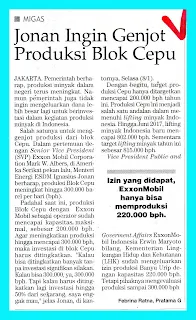Accenture's research shows that most oil and gas companies, including those operating in Southeast Asia, are interested in developing digital technology at their refinery facilities. The application of digital technology will make the company more efficient. Research involving about 200 executives, leaders, and engineers of oil and gas companies shows, 57 percent of respondents will increase digital investment.
"Oil and gas companies realize that they have to invest in digital technology because it will help the maintenance to be more efficient," said Managing Director of Resources Operating Group PT Accenture Mark H. Teoh in a media meeting, Wednesday (2/8), in Jakarta.
Accenture's research noted that digital technology will increase the effectiveness of refinery management (63 percent), reduce operational risk (59 percent), and mitigation in care of refinery facilities (54 percent). Operational cost reduction is the reason to encourage the application of digital technology in oil and gas companies. However, the obstacles faced are still low investment.
According to Mark, awareness of the importance of digital technology emerged due to various factors. The ease and efficiency resulting from the application of digital technology that is felt in other industries besides oil and gas become one of learning. While technically many companies learn from experience if the refinery is suddenly broken. In addition, falling world oil prices are pressing the oil and gas company's finances.
"The cost to run another suddenly damaged refinery is huge. The effect can be on the delay of shipping products so that oil and gas companies can not fulfill the contract, "said Mark.
Data analysis
With an integrated engine, the risk of engine damage will be monitored early. Information technology can also be used to monitor employee stress levels at refineries. Through earlier handling based on data analysis of machines or workers, the costs incurred by the company will eventually be lower.
However, research shows that the development of digital technology raises concerns related to data security of oil and gas companies. Accenture noted, Indonesia's Indonesia Incident Security Response Team on Internet Infrastructure (ID-SIRTII) Indonesia is vulnerable to cyber attacks.
In 2016 there is an increase in cyber attacks by 50 percent over the previous year, therefore 36 percent of respondents call data security as a major obstacle to the adoption of digital technology into oil and gas companies. That number increased to 50 percent when the surveyed were workers in the field of information technology.
Country Managing Director of Accenture Indonesia Neneng Goenadi said the change from manual system to digital technology requires adjustment from the people who work in it. Because, digital technology will integrate people with tools or machines.
IN INDONESIA
Teknologi Bisa Mendorong Efisiensi
Riset Accenture memperlihatkan, sebagian besar perusahaan minyak dan gas, termasuk yang beroperasi di Asia Tenggara, berminat untuk mengembangkan teknologi digital di fasilitas kilangnya. Penerapan teknologi digital akan membuat perusahaan makin efisien. Riset yang melibatkan sekitar 200 eksekutif, pemimpin, dan insinyur perusahaan migas itu menunjukkan, 57 persen responden akan meningkatkan investasi digital.
”Perusahaan migas menyadari bahwa mereka harus investasi untuk teknologi digital karena akan membantu perawatan sehingga semakin efisien,” kata Managing Director Resources Operating Group PT Accenture Mark H Teoh dalam temu media, Rabu (2/8), di Jakarta.
Riset Accenture mencatat, teknologi digital akan meningkatkan efektivitas pengelolaan kilang (63 persen), mengurangi risiko operasional (59 persen), dan mitigasi dalam merawat fasilitas kilang (54 persen). Pengurangan biaya operasional menjadi alasan untuk mendorong penerapan teknologi digital di perusahaan migas. Namun, hambatan yang dihadapi adalah investasi yang masih rendah.
Menurut Mark, kesadaran pentingnya teknologi digital muncul karena berbagai faktor. Kemudahan serta efisiensi yang ditimbulkan dari penerapan teknologi digital yang dirasakan di industri lain selain migas menjadi salah satu pembelajaran. Sementara secara teknis banyak perusahaan belajar dari pengalaman jika kilang tiba-tiba rusak. Selain itu, harga minyak dunia yang turun menekan keuangan perusahaan migas.
”Biaya untuk menjalankan lagi kilang yang rusak mendadak itu besar. Pengaruhnya bisa sampai pada keterlambatan pengapalan produk sehingga perusahaan migas tidak bisa memenuhi kontrak,” ujar Mark.
Analisis data
Dengan mesin yang terintegrasi, risiko kerusakan mesin akan terpantau secara dini. Teknologi informasi juga dapat digunakan untuk memantau tingkat stres karyawan di kilang. Melalui penanganan yang lebih awal berdasarkan analisis data terhadap mesin atau pekerja, biaya yang dikeluarkan perusahaan pun akhirnya akan semakin rendah.
Meski demikian, riset menunjukkan bahwa perkembangan teknologi digital menimbulkan kekhawatiran terkait dengan keamanan data perusahaan migas. Accenture mencatat, Tim Respons Insiden Keamanan Indonesia mengenai Infrastruktur Internet (ID-SIRTII)Indonesia termasuk rentan terhadap serangan siber.
Pada 2016 terjadi peningkatan serangan siber sebesar 50 persen dibandingkan tahun sebelumnya, oleh karena itulah 36 persen responden menyebut keamanan data sebagai hambatan utama diadopsinya teknologi digital ke dalam perusahaan migas. Angka itu meningkat menjadi 50 persen ketika yang disurvei adalah para pekerja di bidang teknologi informasi.
Country Managing Director Accenture Indonesia Neneng Goenadi mengatakan, perubahan dari sistem manual menjadi teknologi digital memerlukan penyesuaian dari orang-orang yang bekerja di dalamnya. Sebab, teknologi digital akan mengintegrasikan orang dengan alat atau mesin.
Kompas, Page-18, Thursday, August 3, 2017








